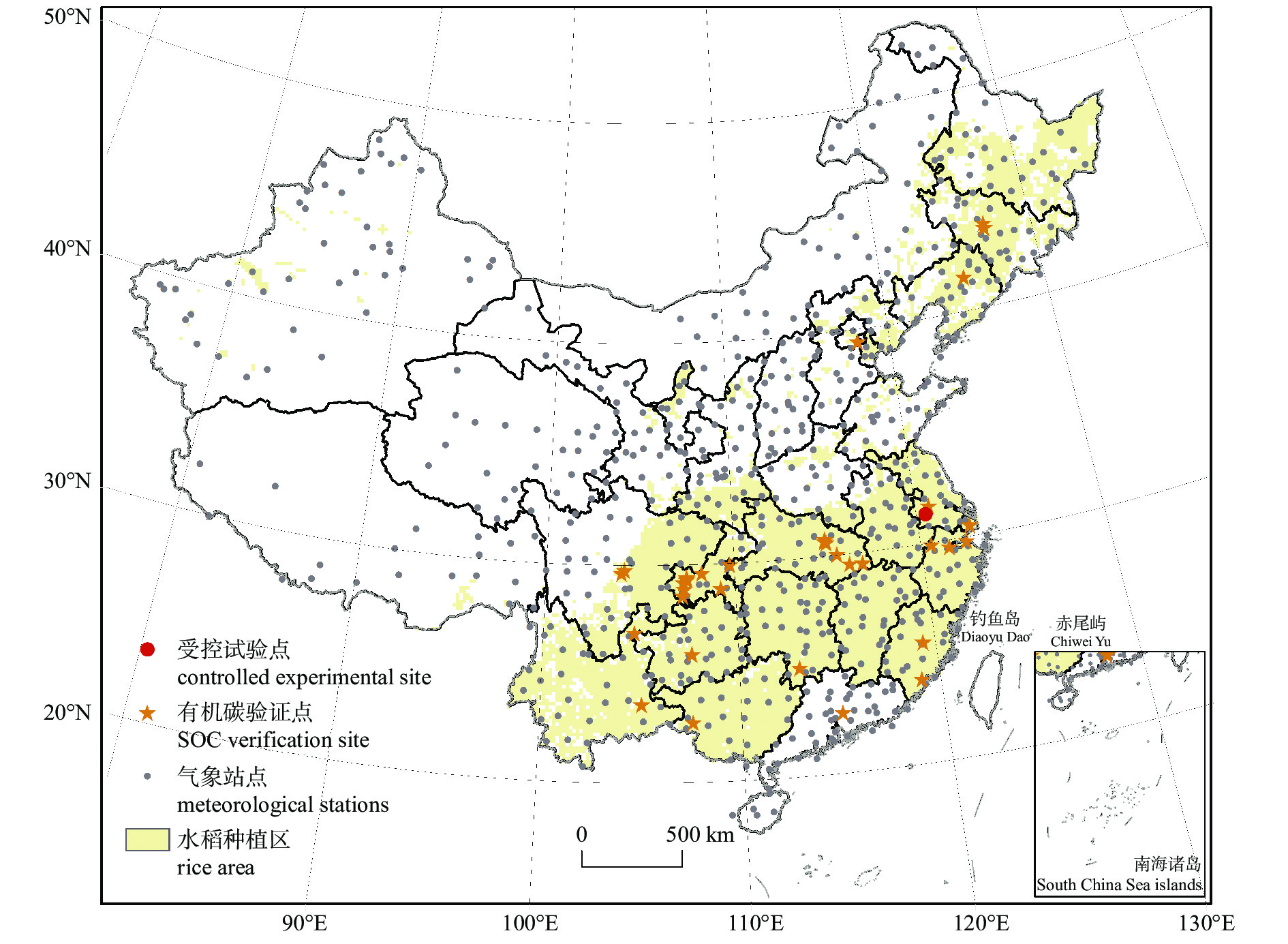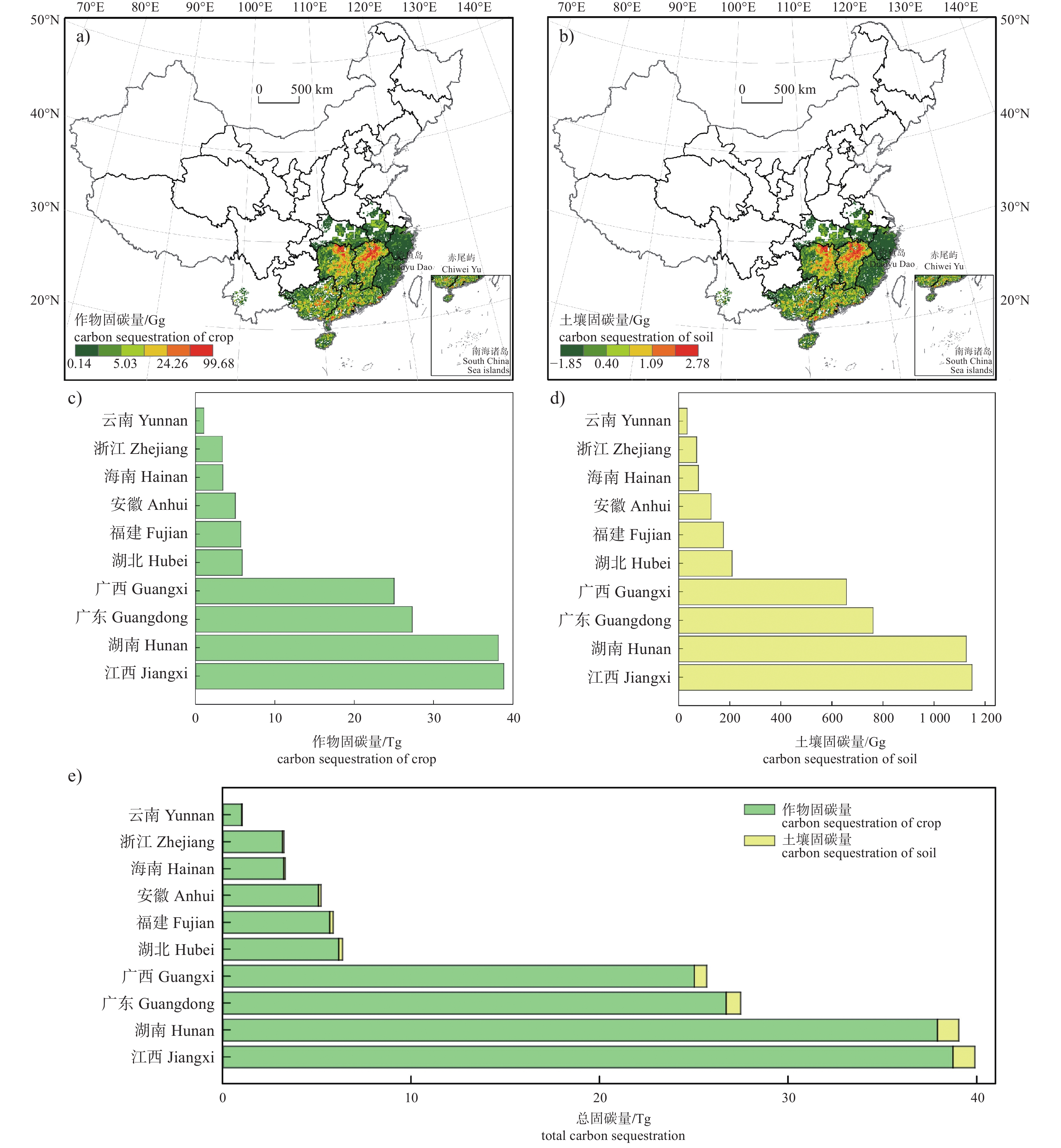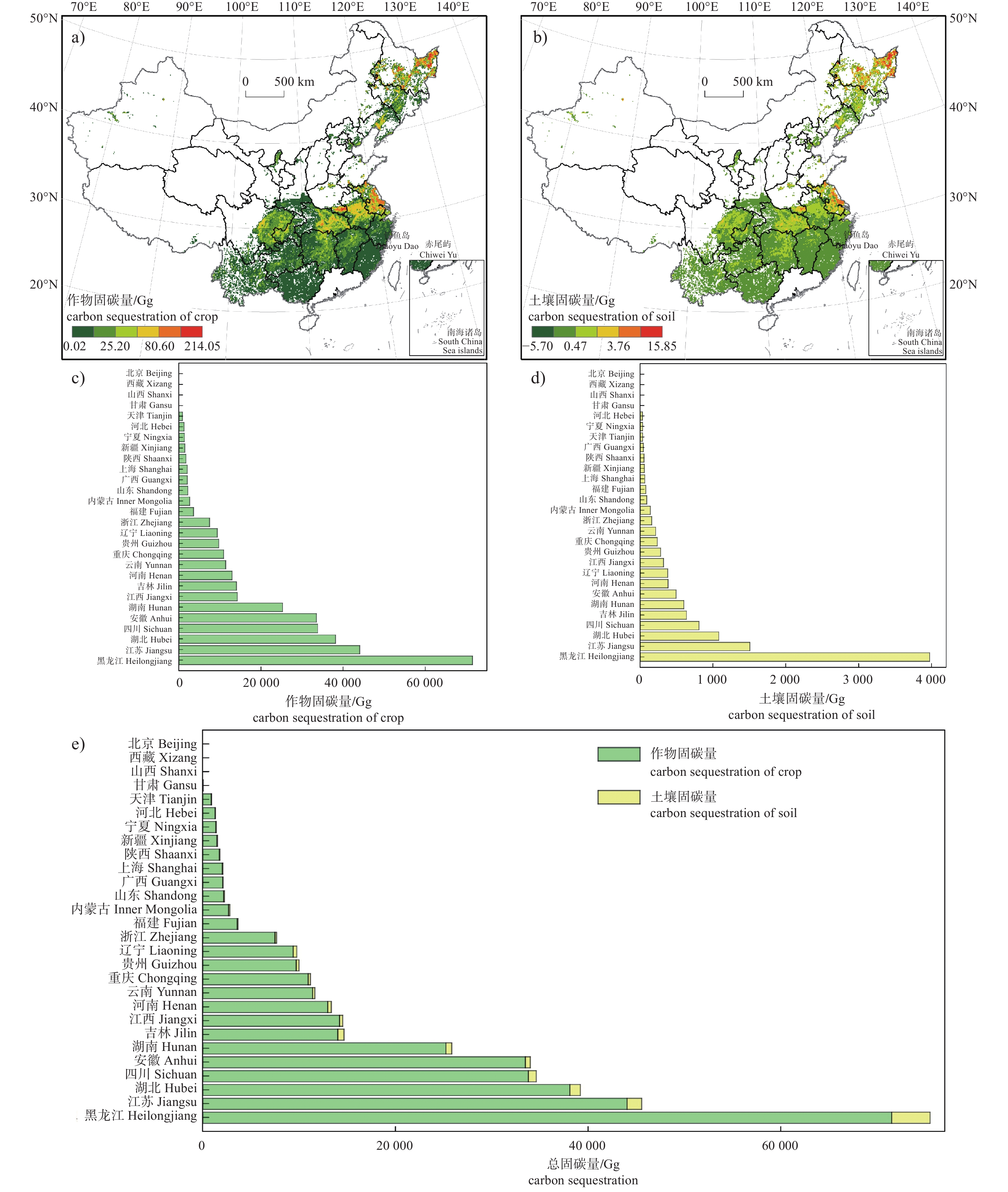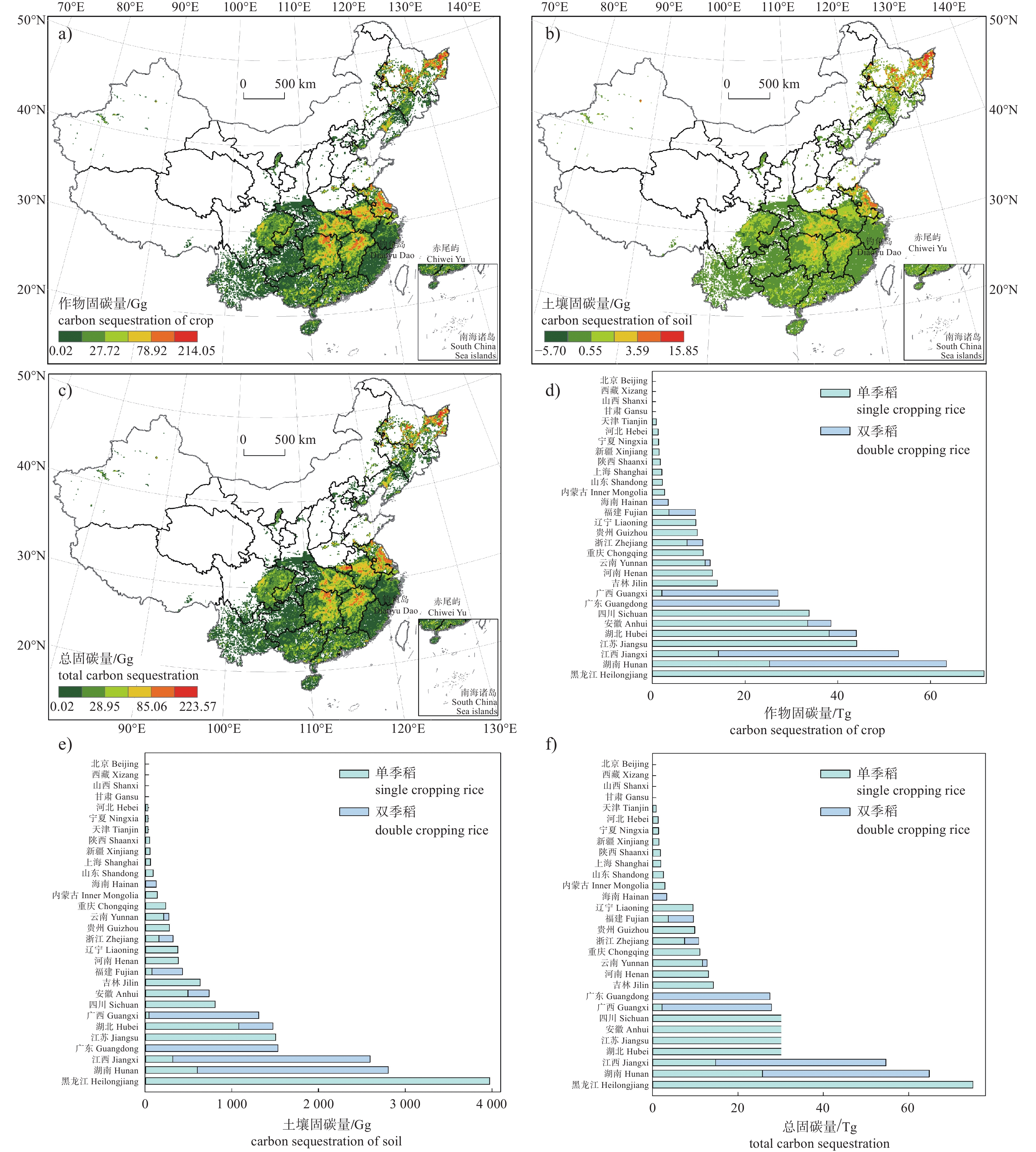中国稻田生态系统固碳效应模拟研究
研究稻田生态系统固碳量的动态变化,为制定与推广耕地固碳减排措施提供依据。
基于3年稻田受控试验数据,校验生物地球化学脱氮—分解作用 (denitrification-decomposition,DNDC)模型,并估算2018—2020年间中国稻田生态系统的固碳量;分析稻田生态系统土壤及作物固碳量的时空分布,评估农田生态系统在实现“碳中和”中的贡献。
DNDC模型模拟的水稻产量及土壤有机碳含量与田间观测结果一致性较高(相关系数均大于等于0.77,平均绝对误差和归一化均方根误差均小于13%);2018—2020年中国水稻固碳总量为523.29 Tg,作物对总固碳量的贡献率达97%以上。江西、湖南、广东和广西的双季稻固碳能力较强,而云南、浙江和海南的相对较弱。单季稻固碳量分布呈现北高南低的空间分布特征,其中黑龙江、江苏和湖北的固碳量较高。湖南、福建、江西和广西的双季稻固碳量大于单季稻,双季稻固碳量占总固碳量的60%以上。
DNDC模型可用于模拟稻田生态系统的碳收支,中国稻田生态系统是重要的碳汇,且呈现出较强的空间异质性。
-
关键词:
- 固碳量 /
- 脱氮—分解(DNDC)模型 /
- 稻田生态系统 /
- 土壤有机碳
Study of Carbon Sequestration Effect of Paddy Ecosystem in China
To study the dynamics of carbon sequestration in the paddy ecosystem, providing a basis for formulating and promoting measures of carbon sequestration and emission reduction in cultivated land.
Based on the data of three-year controlled experiments in paddy fields, the denitrification-decomposition (DNDC) model were verified. The carbon sequestration in paddy ecosystems of China during 2018 to 2020 was estimated by DNDC; the spatial and temporal distributions of soil and crop carbon sequestration in paddy ecosystem of China were analysed; the contribution of farmland ecosystems to achieve carbon neutrality was evaluated.
The rice yield and soil organic carbon content simulated by DNDC model were in good agreement with the field observations (correlation coefficients were higher than or equal to 0.77, mean absolute error and normalized root mean square error were lower than 13%). The total carbon sequestration of rice paddy in China was 523.29 Tg from 2018 to 2020, and the crop contributed more than 97% of the total carbon sequestration. The regions with higher carbon sequestration for double cropping rice were Jiangxi, Hunan, Guangdong and Guangxi, while the regions with lower carbon sequestration for double cropping rice were Yunnan, Zhejiang and Hainan. The carbon sequestration of single cropping rice was lower in the south and higher in the north, with higher carbon sequestration in Heilongjiang, Jiangsu and Hubei. The carbon sequestration of double cropping rice in Hunan, Fujian, Jiangxi and Guangxi was higher than that of single cropping rice, and the carbon sequestration of double cropping rice accounted for more than 60% of the total carbon sequestration.
The DNDC model can be used to simulate carbon budgets in the rice paddy ecosystem. The Chinese paddy fields play an important role in carbon sequestration, with a strong spatial variation.
-
油菜是中国主要油料作物,也是一种重要的饲用蛋白源。甘蓝型油菜是常异花授粉植物,主要是通过风媒传粉和虫媒传粉。已有研究发现油菜花蜜量及其化学成分会影响油菜的昆虫访问和传粉,进而影响油菜产量[1-3]。油菜花的蜜腺在泌蜜前期储存大量淀粉,随着蜜腺腺体发育淀粉粒也逐渐增多。在开花释放花粉粒之前,蜜腺中储存的淀粉粒开始分解,直到花粉粒释放之后,蜜腺细胞中的多糖大量分泌,泌蜜盛期与传粉期吻合,有利于传粉和提高结实率[4-7]。有研究表明:不同品种的油菜花泌蜜量有差异,同时泌蜜量也受栽培管理措施、土壤条件、气候条件和病害等影响[8-9]。植物花蜜一般含有糖类、黄酮、蛋白质和脂类等物质,但其含量在不同植物品种间存在差异,特别是糖的种类和含量差异最为明显[10-12]。油菜生产上品种类型较多,且不同品种间产量差异较大。目前,有关油菜花蜜的化学成分及含量研究鲜见报道。笔者以5个常规甘蓝型油菜品种为供试材料,对油菜单花泌蜜量、蜜腺面积、花蜜化学成分及其含量进行研究,旨在为研究通过昆虫传粉提高油菜产量以及油菜花蜜腺遗传改良提供理论依据。
1. 材料与方法
1.1 供试材料
5个供试甘蓝型油菜品种分别为滇早油16、滇油1号、花油8号、ZY511和黄矮早,种子由云南农业大学油菜研究室提供。
1.2 试验方法
1.2.1 材料种植
2017年10月中旬,将油菜种子播种于云南农业大学后山农场同一地块,按常规方法进行油菜栽培管理。
1.2.2 花蜜收集
对将要开放的花朵进行标记,在整株花朵开花后第3天上午12:00左右采摘花朵放入自封袋中带回实验室,每个品种采集100朵花。采用离心法收集花蜜:先用消毒镊子、剪刀去除花萼、花瓣、雄蕊和雌蕊,保留花托和蜜腺,并防止花蜜损失,然后放入已剪好的并在底端扎满小眼的一次性手套的手指袋中,每10朵花放入1个手指袋,再放入10 mL的离心管。4 ℃、1 000 r/min离心5 min。将收集的花蜜转移到2 mL离心管中,定量,4 ℃保存。
1.2.3 油菜花蜜腺面积的测定
将开花后第3天的油菜花朵去除花萼、花瓣、雄蕊和雌蕊,保留花托和蜜腺,然后平置于显微镜下,使蜜腺一面朝上,分别测定每朵花4个蜜腺的长轴和短轴的长度。油菜花的蜜腺呈椭圆状,因此每个蜜腺的表面积按椭圆形面积公式计算,4个蜜腺面积之和为每朵花的总蜜腺面积。每个品种取10朵花单花蜜腺面积的平均值。
1.2.4 油菜花蜜中糖含量的测定
采用蒽酮比色法[13]测定油菜花蜜的总糖含量;采用高效液相色谱法[14]测定油菜花蜜的葡萄糖、果糖、蔗糖和海藻糖的含量。高效液相色谱仪为美国Waters 510型,色谱柱为Kro-masilNH2(250 mm×4.6 mm),流动相为纯水,流速0.6 mL/min,柱温80 ℃,进样量10 μL。
1.2.5 油菜花蜜中类黄酮含量的测定
采用分光光度法[15]测定油菜花蜜的类黄酮含量。
1.2.6 油菜花蜜中蛋白质和氨基酸含量测定
采用BCA蛋白定量法[16]测定油菜花蜜中蛋白质含量;采用酸水解—全自动氨基酸分析仪法测定油菜花蜜中游离氨基酸含量[17]。
1.3 数据分析
采用SPSS22.0软件进行ANOVA统计分析,Duncan’s法检验品种间差异的显著性(P<0.05),并对不同油菜品种单花蜜量与单花蜜腺面积进行相关性分析(P<0.01)。
2. 结果与分析
2.1 不同油菜品种单花蜜量与蜜腺面积及其相关性
不同油菜品种单花泌蜜量差异显著(图1)。在供试的5个品种中,滇油1号单花泌蜜量最高,单花开花后第3天的泌蜜量为1.005 μL,其次从高到低依次为滇早油16、黄矮早、花油8号和ZY511,单花泌蜜量分别为0.833、0.736、0.725和0.717 μL。不同油菜品种的单花蜜腺面积也存在显著差异(图1)。滇油1号单花蜜腺面积最大,达0.525 cm2,其次从高到低依次为滇早油16、黄矮早、花油8号和ZY511,单花蜜腺面积分别为0.443、0.391、0.375和0.327 cm2。同时,对不同油菜品种的单花泌蜜量与单花蜜腺面积进行相关性分析表明:5个油菜品种单花泌蜜量与单花蜜腺面积呈极显著正相关(P<0.01),其相关性系数达0.956。
2.2 不同油菜品种花蜜中不同糖类含量分析
对油菜花蜜中可溶性总糖、蔗糖、葡萄糖、果糖、海藻糖和麦芽糖进行测定,除麦芽糖未检测出,其他糖类均已检测到(表1)。供试油菜品种中花蜜中可溶性总糖含量品种间差异显著,滇油1号总糖含量最高,达374.5 mg/mL,其他品种花蜜中可溶性总糖含量比滇油1号低50%以上,黄矮早总糖含量最低,为109.6 mg/mL。不同油菜品种花蜜中葡萄糖和果糖含量较高,均达49 mg/mL以上,且滇油1号的葡萄糖、果糖含量均显著高于其他品种,分别为177.1、194.4 mg/mL。不同油菜品种花蜜中蔗糖和海藻糖含量较低,均小于1 mg/mL,其中滇早油16和滇油1号花蜜中蔗糖、海藻糖含量显著高于其他品种。
表 1 不同油菜品种花蜜中不同糖类含量Table 1. Different sugar content in nectar from different rapeseed cultivars品种cultivars 总糖total sugar 蔗糖sucrose 葡萄糖glucose 果糖fructose 海藻糖trehalose 滇早油16 DZY16 131.6±0.9 b 0.57±0.03 a 55.5±0.2 b 72.0±0.9 b 0.62±0.01 a 滇油1号 DY1 374.5±0.9 a 0.47±0.05 b 177.1±0.4 a 194.4±0.7 a 0.65±0.01 a 花油8号 HY8 122.7±0.8 c 0.05±0.05 c 49.6±0.5 d 72.3±0.9 b 0.32±0.02 c ZY511 115.4±0.6 d 0.03±0.02 c 51.2±0.4 c 61.6±0.4 c 0.48±0.03 b 黄矮早 HAZ 109.6±0.7 e 0.13±0.03 c 51.4±0.6 c 56.8±0.4 d 0.35±0.03 c 注:同列数字后不同字母表示不同品种间差异显著 (P<0.05)。
Note: Values followed by different letters indicate significant difference among cultivars (P<0.05).2.3 不同油菜品种花蜜中类黄酮含量分析
花蜜中类黄酮在植物抵御外源生物入侵、传递发育信号、抗氧化性和防紫外辐射等方面起重要作用[18]。不同油菜品种花蜜中类黄酮含量较低,5个品种的类黄酮含量均小于0.2 mg/mL。不同油菜品种间类黄酮含量差异显著(图2)。滇早油16的类黄酮含量显著高于其他品种,达0.165 mg/mL;其次是花油8号和ZY511,分别为0.142和0.114 mg/mL;滇油1号和黄矮早类黄酮含量最低,分别为0.096和0.091 mg/mL,且2个品种间类黄酮含量差异不显著。
2.4 不同油菜品种花蜜中蛋白质含量分析
对不同油菜品种花蜜中蛋白质和游离氨基酸含量进行检测,花蜜中游离氨基酸均未检测到。油菜花蜜富含蛋白质,测试5个品种花蜜中蛋白质含量均大于100 mg/mL,但不同油菜品种间花蜜中蛋白含量存在显著差异(图3)。蛋白质含量最高的是滇油1号,达289.1 mg/mL;其次是ZY511,达238.1 mg/mL;花油8号、滇早油16和黄矮早花蜜中蛋白含量分别为127.4、122.8和109.4 mg/mL。
3. 讨论
花蜜的化学成分及其传粉功能是如今植物生殖生物学研究中最为重要的领域之一。已有研究表明:不同植物花蜜的化学成分及其含量对虫媒传粉的影响较大[19]。蜜蜂采集含有相同比例的葡萄糖、果糖和蔗糖的草木犀花蜜比采集含有蔗糖较多的苜蓿、杂三叶草或红三叶草的花蜜更积极[19]。不同昆虫对花蜜中氨基酸的需求不一样,氨基酸的种类及含量也会影响昆虫的访花授粉,从而影响产量。BERTAZZINI等[20]通过选择饲喂试验发现:当同时提供2种富含不同氨基酸的花蜜时(脯氨酸、丙氨酸、丝氨酸),蜜蜂更喜欢脯氨酸,其次为丙氨酸,而丝氨酸对蜜蜂具有一定的驱避性。不同品种的油菜花泌蜜量不同,并受环境因素的影响。对云南5个品种的油菜花泌蜜量研究发现:不同品种的油菜花泌蜜量、花蜜总糖量和总糖质量浓度也不一样,并且5个品种的花蜜总糖质量浓度均随温度升高而升高、随湿度增加而小幅降低,温度22 ℃左右、湿度65%左右时油菜花蜜总糖质量浓度最高[21]。本研究与上述研究具有一定的相似性,本研究发现:不同品种的油菜花蜜腺大小不同,泌蜜量也不一样,油菜花的泌蜜量与其蜜腺大小呈显著正相关;不同油菜品种的花蜜化学组成基本一致,富含蛋白质和可溶性糖,微含类黄酮,没有检测出游离氨基酸和脂肪酸;不同油菜品种花蜜中可溶性总糖含量、蛋白质含量均呈显著性差异,并且可溶性总糖主要为葡萄糖和果糖,这可能是油菜在起源进化过程中产生的,为吸引蜜蜂访花传粉,使其成为常异花授粉植物。已有文章报道,有昆虫访花授粉的油菜会比封闭条件下的油菜产量高出13.7%~20.4%[22]。不同品种的油菜花泌蜜量及其各化学成分的含量不同,从而影响蜜蜂访花传粉,并导致不同油菜品种产量产生差异。因此,在油菜育种中可考虑选育吸引昆虫访花授粉的品种来提高油菜产量,本研究结果为油菜新品种选育和增产提供新的评价指标。
-
图 1 气象站点、试验点、水稻种植区和验证点位置图
注:基于自然资源部标准地图服务系统网站下载的GS(2020)4619号标准地图制作,底图边界无修改;下同。
Figure 1. Location map of meteorological stations, experimental sites, rice area and verification site
Note: Based on the standard map of GS(2020)4619 downloaded from the website of the standard map service system of the Ministry of Natural Resources, the boundary of the base map is not modified; the same as below.
表 1 水稻田受控试验设计
Table 1 Design of controlled experiments in paddy fields
移栽日期 (yyyy-mm-dd)
transplanting date收获日期 (yyyy-mm-dd)
harvest date生长时间/d
growth time2015-07-01 2015-11-12 135 2016-06-30 2016-11-07 131 2017-06-20 2017-11-11 150 -
[1] 李玉波, 刘国辉, 许清涛, 等. 吉林省农田生态系统碳源/汇及碳足迹分析[J]. 白城师范学院学报, 2020, 34(5): 37. [2] LAL R. Soil carbon sequestration impacts on global climate change and food security[J]. Science, 2004, 304(5677): 1623. DOI: 10.1126/science.1097396.
[3] 刘庆花. 中国水稻土有机碳空间分布及其主要影响因素研究[D]. 南京: 中国科学院南京土壤研究所, 2006. [4] 佘玮, 黄璜, 官春云, 等. 我国典型农作区作物生产碳汇功能研究[J]. 中国工程科学, 2016, 18(1): 106. DOI: 10.15302/J-CESS-2016013. [5] LAL R. Global potential of soil carbon sequestration to mitigate the greenhouse effect[J]. Critical Review in Plant Science, 2003, 22(2): 151. DOI: 10.1080/713610 854.
[6] 黄继元. 基于DNDC模型的洱海流域稻田氮素损失模拟研究[D]. 哈尔滨: 东北农业大学, 2020. [7] LIU K, FANG L P, LI F B, et al. Sustainability assessment and carbon budget of chemical stabilization based multi-objective remediation of Cd contaminated paddy field[J]. Science of the Total Environment, 2022, 819(6): 152022. DOI: 10.1016/j.scitotenv.2021.152022.
[8] CUI Y, KHAN S U, DENG Y, et al. Spatiotemporal heterogeneity, convergence and its impact factors: perspective of carbon emission intensity and carbon emission per capita considering carbon sink effect[J]. Environmental Impact Assessment Review, 2022, 92(2): 106699. DOI: 10.1016/j.eiar.2021.106699.
[9] 张娜, 于贵瑞, 赵士洞, 等. 基于遥感和地面数据的景观尺度生态系统生产力的模拟[J]. 应用生态学报, 2003, 14(5): 643. DOI: 10.13287/j.1001-9332.2003.0146. [10] YUAN W P, LIU S G, ZHOU G S, et al. Deriving a light use efficiency model from eddy covariance flux data for predicting daily gross primary production across biomes[J]. Agricultural and Forest Meteorology, 2007, 143(3/4): 189. DOI: 10.1016/j.agrformet.2006.12.001.
[11] HWANG Y, RYU Y, HUANG Y, et al. Comprehensive assessments of carbon dynamics in an intermittently-irrigated rice paddy[J]. Agricultural and Forest Meteorology, 2020, 285/286: 107933. DOI: 10.1016/j.agrformet. 2020.107933.
[12] DIAZ M B, ROBERTI D R, CARNEIRO J V, et al. Dynamics of the superficial fluxes over a flooded rice paddy in southern Brazil[J]. Agricultural and Forest Meteorology, 2019, 276/277: 107650. DOI: 10.1016/j.agrformet. 2019.107650.
[13] LIU J G, LAI D Y F. Subtropical mangrove wetland is a stronger carbon dioxide sink in the dry than wet seasons[J]. Agricultural & Forest Meteorology, 2019, 278(3): 107644. DOI: 10.1016/j.agrformet.2019.107644.
[14] LI C S, FROLKING S, FROLKING T A. A model of nitrous oxide evolution from soil driven by rainfall events: 1. Model structure and sensitivity[J]. Journal of Geophysical Research: Atmospheres, 1992, 97(D9): 9759. DOI: 10.1029/92JD00509.
[15] LI C S, FROLKING S, FROLKING T A. A model of nitrous oxide evolution from soil driven by rainfall events: 2. Model applications[J]. Journal of Geophysical Research: Atmospheres, 1992, 97(D9): 9777. DOI: 10.1029/92- JD00510.
[16] 林文鹏, 王臣立, 赵敏, 等. 基于森林清查和遥感的城市森林净初级生产力估算[J]. 生态环境, 2008, 17(2): 766. DOI: 10.16258/j.cnki.1674-5906.2008.02.076. [17] 于贵瑞, 王秋凤, 朱先进. 区域尺度陆地生态系统碳收支评估方法及其不确定性[J]. 地理科学进展, 2011, 30(1): 103. DOI: 10.11820/dlkxjz.2011.01.013. [18] 于贵瑞, 孙晓敏. 中国陆地生态系统碳通量观测技术及时空变化特征[M]. 北京: 科学出版社, 2008. [19] 付伟, 罗明灿, 陈建成. 碳足迹及其影响因素研究进展与展望[J]. 林业经济, 2021, 43(8): 39. DOI: 10.13843/j.cnki.lyjj.20211017.001. [20] 张乐勤, 许信旺. 气候变暖背景下碳足迹研究现状与展望[J]. 中国科技论坛, 2011(8): 99. DOI: 10.13580/j.cnki. fstc.2011.08.016. [21] 黄祖辉, 米松华. 农业碳足迹研究: 以浙江省为例[J]. 农业经济问题, 2011, 32(11): 40. DOI: 10.13246/j.cnki.iae.2011.11.007. [22] WANG Z, ZHANG X Y, LIU L, et al. Estimates of methane emissions from Chinese rice fields using the DNDC model[J]. Agricultural and Forest Meteorology, 2021, 303: 108368. DOI: 10.1016/j.agrformet.2021.1083 68.
[23] ANANTHA K C, MAJUMDER S P, BADOLE S, et al. Pools of organic carbon in soils under a long-term rice-rice system with different organic amendments in hot, sub-humid India[J]. Carbon Management, 2020, 11(4): 331. DOI: 10.1080/17583004.2020.1783624.
[24] LI H, WANG L G, LI J Z, et al. The development of China-DNDC and review of its applications for sustaining Chinese agriculture[J]. Ecological Modelling, 2017, 348(9): 1. DOI: 10.1016/j.ecolmodel.2017.01.003.
[25] LI S M, LI J M, LI C S, et al. Testing the RothC and DNDC models against long-term dynamics of soil organic carbon stock observed at cropping field soils in North China[J]. Soil and Tillage Research, 2016, 163: 290. DOI: 10.1016/j.still.2016.07.001.
[26] SMAKGAHN K, FUMOTO T, YAGI K. Effect of rice straw incorporation on methane emission and rice yields from rice cropping system by DNDC-Rice model[J]. International Journal of Global Warming, 2018, 16(1): 54. DOI: 10.1504/IJGW.2018.094310.
[27] BORTOLON E S O, MIELNICZUK J, TORNQUIST C G, et al. Validation of the Century model to estimate the impact of agriculture on soil organic carbon in Southern Brazil[J]. Geoderma, 2011, 167/168: 156. DOI: 10.1016/j.geoderma.2011.08.008.
[28] 李长生. 生物地球化学的概念与方法: DNDC模型的发展[J]. 第四纪研究, 2001, 21(2): 89. DOI: 10.3321/j.issn:1001-7410.2001.02.001. [29] FROLKING S, XIAO X M, ZHUANG Y H, et al. Agricultural land-use in China: a comparison of area estimates from ground-based census and satellite-borne remote sensing[J]. Global Ecology and Biogeography, 1999, 8(5): 407. DOI: 10.1046/j.1365-2699.1999.00157.x.
[30] SALAS W, GRENN P, FROLKING S E, et al. Estimating irrigation water use for California agriculture: 1950 to present[M]. Berkeley: California Climate Change Center, 2005.
[31] LI C S. Quantifying greenhouse gas emissions from soils: scientific basis and modeling approach[J]. Soil Science and Plant Nutrition, 2007, 53(4): 344. DOI: 10.1111/j.1747-0765.2007.00133.x.
[32] CAI Z C, SAWAMOTO T, LI C S, et al. Field validation of the DNDC model for greenhouse gas emissions in East Asian cropping systems[J]. Global Biogeochemical Cycles, 2003, 17(4): 1107. DOI: 10.1029/2003GB0020 46.
[33] LI C S, MOSIER A, WASSMANN R, et al. Modeling greenhouse gas emissions from rice-based production systems: sensitivity and upscaling[J]. Global Biogeochemical Cycles, 2004, 18(1): 1. DOI: 10.1029/2003GB00- 2045.
[34] BABU Y J, LI C, FROLKING S, et al. Field validation of DNDC model for methane and nitrous oxide emissions from rice-based production systems of India[J]. Nutrient Cycling in Agroecosystems, 2006, 74(2): 157. DOI: 10.1007/s10705-005-6111-5.
[35] TANG H J, QIU J J, VAN RANST E, et al. Estimations of soil organic carbon storage in cropland of China based on DNDC model[J]. Geoderma, 2006, 134(1/2): 200. DOI: 10.1016/j.geoderma.2005.10.005.
[36] CHEN H, YU C Q, LI C S, et al. Modeling the impacts of water and fertilizer management on the ecosystem service of rice rotated cropping systems in China[J]. Agriculture, Ecosystems & Environment, 2016, 219: 49. DOI: 10.1016/j.agee.2015.11.023.
[37] WANG L G, QIU J J, TANG H J, et al. Modelling soil organic carbon dynamics in the major agricultural regions of China[J]. Geoderma, 2008, 147(1/2): 47. DOI: 10.1016/j.geoderma.2008.07.009.
[38] LI C S, QIU J J, FROLKING S, et al. Reduced methane emissions from large-scale changes in water management of China’s rice paddies during 1980-2000[J]. Geophysical Research Letters, 2002, 29(20): 1972. DOI: 10.1029/2002GL015370.
[39] ZHANG Y, WANG Y Y, SU S L, et al. Quantifying methane emissions from rice paddies in Northeast China by integrating remote sensing mapping with a biogeochemical model[J]. Biogeosciences, 2011, 8(5): 1225. DOI: 10.5194/bg-8-1225-2011.
[40] LI C S, ZHUANG Y H, FROLKING S, et al. Modeling soil organic carbon change in croplands of China[J]. Ecological Applications, 2003, 13(2): 327. DOI: 10.1890/1051-0761(2003)013[0327:MSOCCI]2.0.CO;2.
[41] LI C S, FROLKING S, XIAO X M, et al. Modeling impacts of farming management alternatives on CO2, CH4, and N2O emissions: a case study for water management of rice agriculture of China[J]. Global Biogeochemical Cycles, 2005, 19(3): 1. DOI: 10.1029/2004GB002341.
[42] BABU Y J, LI C S, FROLKING S, et al. Modelling of methane emissions from rice-based production systems in India with the denitrification and decomposition model: field validation and sensitivity analysis[J]. Current Science, 2005, 89(11): 1904.
[43] WANG Q M, LIANG X, WANG Y C, et al. Assessment of nitrogen hotspots induced by cropping systems in the Bohai Rim region in China by integrating DNDC modelling and the reactive nitrogen spatial intensity (NrSI) framework[J]. Environmental Research Letters, 2020, 15(10): 105008. DOI: 10.1088/1748-9326/abb052.
[44] WU X, KANG X M, LIU W J, et al. Using the DNDC model to simulate the potential of carbon budget in the meadow and desert steppes in Inner Mongolia, China[J]. Journal of Soils and Sediments, 2018, 18(1): 63. DOI: 10.1007/s11368-017-1737-x.
[45] 李颖. 农业碳汇功能及其补偿机制研究: 以粮食作物为例[D]. 泰安: 山东农业大学, 2014. [46] 潘根兴, 赵其国. 我国农田土壤碳库演变研究: 全球变化和国家粮食安全[J]. 地球科学进展, 2005, 20(4): 384. DOI: 10.3321/j.issn:1001-8166.2005.04.003. [47] 王绍强, 周成虎, 李克让, 等. 中国土壤有机碳库及空间分布特征分析[J]. 地理学报, 2000, 55(5): 533. DOI: 10.11821/xb200005003. [48] 张君, 宫渊波, 王巧红. 土壤碳现状及其对全球气候变化的响应[J]. 四川林业科技, 2005, 26(5): 56. DOI: 10.16779/j.cnki.1003-5508.2005.05.010. [49] 吴世蓉, 位佳, 邱龙霞, 等. 基于大比例尺数据库的福建省耕地土壤固碳速率和潜力研究[J]. 土壤学报, 2022, 59(5): 1293. DOI: 10.11766/trxb202012040671. [50] 江赜伟, 杨士红, 丁洁, 等. 基于DNDC模型的不同水文年稻田水碳管理模式优化[J]. 干旱地区农业研究, 2020, 38(4): 93. DOI: 10.7606/j.issn.1000-7601.2020.04.12. [51] 徐胜祥, 史学正, 赵永存, 等. 不同耕作措施下江苏省稻田土壤固碳潜力的模拟研究[J]. 土壤, 2012, 44(2): 253. DOI: 10.13758/j.cnki.tr.2012.02.010. [52] 韩冰, 王效科, 欧阳志云. 中国农田生态系统土壤碳库的饱和水平及其固碳潜力[J]. 农村生态环境, 2005, 21(4): 6. DOI: 10.3969/j.issn.1673-4831.2005.04.002. [53] 联合国粮农组织. 世界土壤资源报告: FAO-UNESCO世界土壤图图例(修订版)[M]. 罗马: FAO, 1996. [54] 汪振. 大气氮沉降对中国水稻产量和甲烷排放影响研究[D]. 南京: 南京大学, 2020. [55] WANG Z, ZHANG X Y, LIU L, et al. Evaluating the effects of nitrogen deposition on rice ecosystems across China[J]. Agriculture, Ecosystems & Environment, 2019, 285(4): 106617. DOI: 10.1016/j.agee.2019.106617.
[56] WANG Z, ZHANG X Y, LIU L, et al. Inhibition of methane emissions from Chinese rice fields by nitrogen deposition based on the DNDC model[J]. Agricultural Systems, 2020, 184: 102919. DOI: 10.1016/j.agsy.2020.102919.
[57] 作者不详. 速读《2019年中国气候公报》[N/OL]. 中国气象报, 2020-02-28(3)[2022-10-21]. [58] 吴良泉, 武良, 崔振岭, 等. 中国水稻区域氮磷钾肥推荐用量及肥料配方研究[J]. 中国农业大学学报, 2016, 21(9): 1. DOI: 10.11841/j.issn.1007-4333.2016.09.01. [59] 郑永丹. 中国主要粮食作物生育期时空格局及其变化[D]. 武汉: 华中师范大学, 2015. [60] YAN X Y, CAI Z C, OHARA T, et al. Methane emission from rice fields in mainland China: amount and seasonal and spatial distribution[J]. Journal of Geophysical Research: Atmospheres, 2003, 108(D16): 4505. DOI: 10.1029/2002JD003182.
[61] ZENG X M, HAN B J, XU F S, et al. Effects of modified fertilization technology on the grain yield and nitrogen use efficiency of midseason rice[J]. Field Crops Research, 2012, 137: 203. DOI: 10.1016/j.fcr.2012.08.012.
[62] 熊秋芬, 黄玫, 熊敏诠, 等. 基于国家气象观测站逐日降水格点数据的交叉检验误差分析[J]. 高原气象, 2011, 30(6): 1615. [63] 乔星华, 董晓华, 孙媛, 等. 土壤水—汽—热耦合运移的数值模拟研究与验证[J]. 节水灌溉, 2021(3): 37. DOI: 10.3969/j.issn.1007-4929.2021.03.007. [64] TANG X L, ZHAO X, BAI Y F, et al. Carbon pools in China’s terrestrial ecosystems: new estimates based on an intensive field survey[J]. Proceedings of the National Academy of Sciences, 2018, 115(16): 4021. DOI: 10.1073/pnas.1700291115.
[65] 鲁春霞, 谢高地, 肖玉, 等. 我国农田生态系统碳蓄积及其变化特征研究[J]. 中国生态农业学报, 2005, 13(3): 35. [66] 王雅楠, 张琪琳, 陈伟. 基于碳汇功能的省域农业碳排放及减排潜力研究: 以中国三种主要粮食作物为例[J]. 重庆社会科学, 2022(5): 58. DOI: 10.19631/j.cnki.css.2022.005.005. [67] PAN G X, LI L Q, WU L S, et al. Storage and sequestration potential of topsoil organic carbon in China’s paddy soils[J]. Global Change Biology, 2004, 10(1): 79. DOI: 10.1111/j.1365-2486.2003.00717.x.
[68] 赵峥. 基于DNDC模型的稻田氮素流失及温室气体排放研究[D]. 上海: 上海交通大学, 2016. [69] 雷豪杰, 李贵春, 丁武汉, 等. 设施菜地土壤氮素运移及淋溶损失模拟评价[J]. 中国生态农业学报(中英文), 2021, 29(1): 38. DOI: 10.13930/j.cnki.cjea.200570. [70] 方精云, 郭兆迪, 朴世龙, 等. 1981—2000年中国陆地植被碳汇的估算[J]. 中国科学(D辑: 地球科学), 2007, 37(6): 804. [71] 赵宁, 周蕾, 庄杰, 等. 中国陆地生态系统碳源/汇整合分析[J]. 生态学报, 2021, 41(19): 7648. DOI: 10.5846/stxb202004271012. [72] 杨元合, 石岳, 孙文娟, 等. 中国及全球陆地生态系统碳源汇特征及其对碳中和的贡献[J]. 中国科学(生命科学), 2022, 52(4): 534. DOI: 10.1360/SSV-2021-0362. [73] YU G R, LI X R, WANG Q F, et al. Carbon storage and its spatial pattern of terrestrial ecosystem in China[J]. Journal of Resources and Ecology, 2010, 1(2): 97. DOI: 10.3969/j.issn.1674-764x.2010.02.001.
[74] 罗怀良. 中国农田作物植被碳储量研究进展[J]. 生态环境学报, 2014, 23(4): 692. DOI: 10.16258/j.cnki.1674-5906.2014.04.021. [75] 吴昊玥, 孟越, 黄瀚蛟, 等. 中国耕地低碳利用绩效测算与时空分异[J]. 自然资源学报, 2022, 37(5): 1148. DOI: 10.31497/zrzyxb.20220504. [76] 田云, 张俊飚. 中国农业生产净碳效应分异研究[J]. 自然资源学报, 2013, 28(8): 1298. DOI: 10.11849/zrzyxb.2013.08.003. [77] 潘根兴, 李恋卿, 郑聚锋, 等. 土壤碳循环研究及中国稻田土壤固碳研究的进展与问题[J]. 土壤学报, 2008, 45(5): 901. DOI: 10.3321/j.issn:0564-3929.2008.05.017. [78] 祝贞科, 肖谋良, 魏亮, 等. 稻田土壤固碳关键过程的生物地球化学机制及其碳中和对策[J]. 中国生态农业学报(中英文), 2022, 30(4): 592. DOI: 10.12357/cjea.2021 0748. -
期刊类型引用(6)
1. 徐铭阳,丁孝羊,关哲允,刘大壮,孙妍妍,王亮,谷岩,闫昊. 高异交率大豆种质资源花朵气-质成分及农艺性状特征分析. 大豆科学. 2025(02): 1-11 .  百度学术
百度学术
2. 谢文杰,陈西玲,石国朝,张鹏,李新岗,张睿,段晓姗. 设施栽培‘冬枣’花发育和花蜜分泌规律的研究. 园艺学报. 2024(12): 2735-2742 .  百度学术
百度学术
3. 张江超,刘强,黄家兴,高飞,陈敏,马卫华,姜玉锁. 梨花和油菜花朵特征对蜜蜂访花偏爱性的影响. 环境昆虫学报. 2022(04): 910-920 .  百度学术
百度学术
4. 伦菡宁,叶忠铭,杨春锋. 植物花蜜提取、保存与检测分析方法及比较. 植物科学学报. 2021(02): 201-207 .  百度学术
百度学术
5. 雷佳,马卫华,李捷,武文卿,宋怀磊,宋卓琴,申晋山,李立新,王怡. 大豆不同品种泌蜜量和花朵挥发性成分分析. 山西农业科学. 2021(07): 807-812 .  百度学术
百度学术
6. 皮竟,黄桃翠,黄华磊,唐丽桂,胡承伟,李艳花. 重庆油菜产业现状及发展对策. 农学学报. 2020(10): 50-54 .  百度学术
百度学术
其他类型引用(4)




 下载:
下载:







